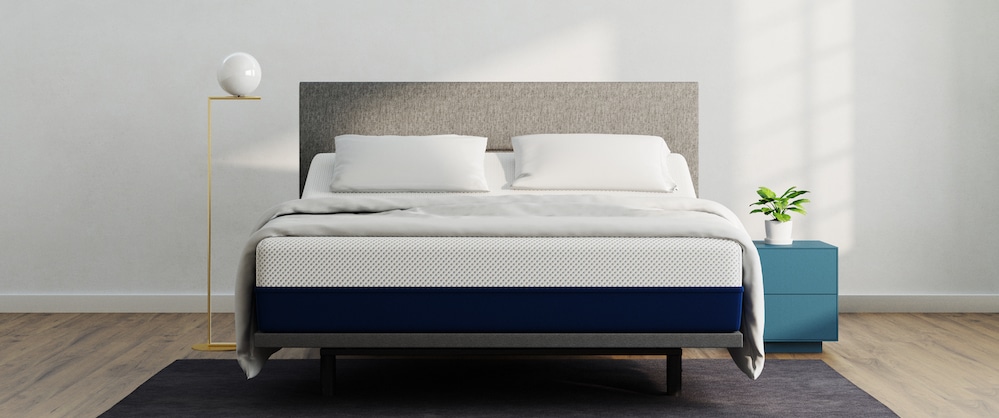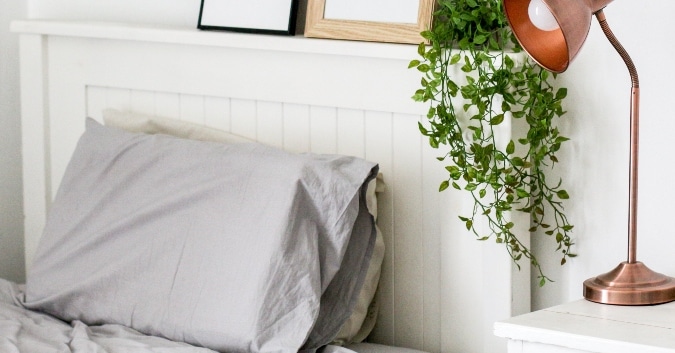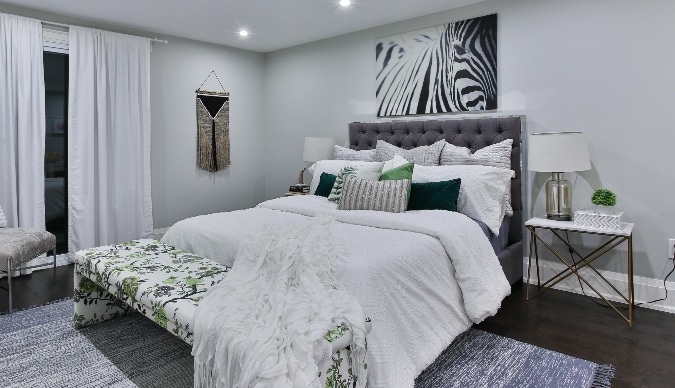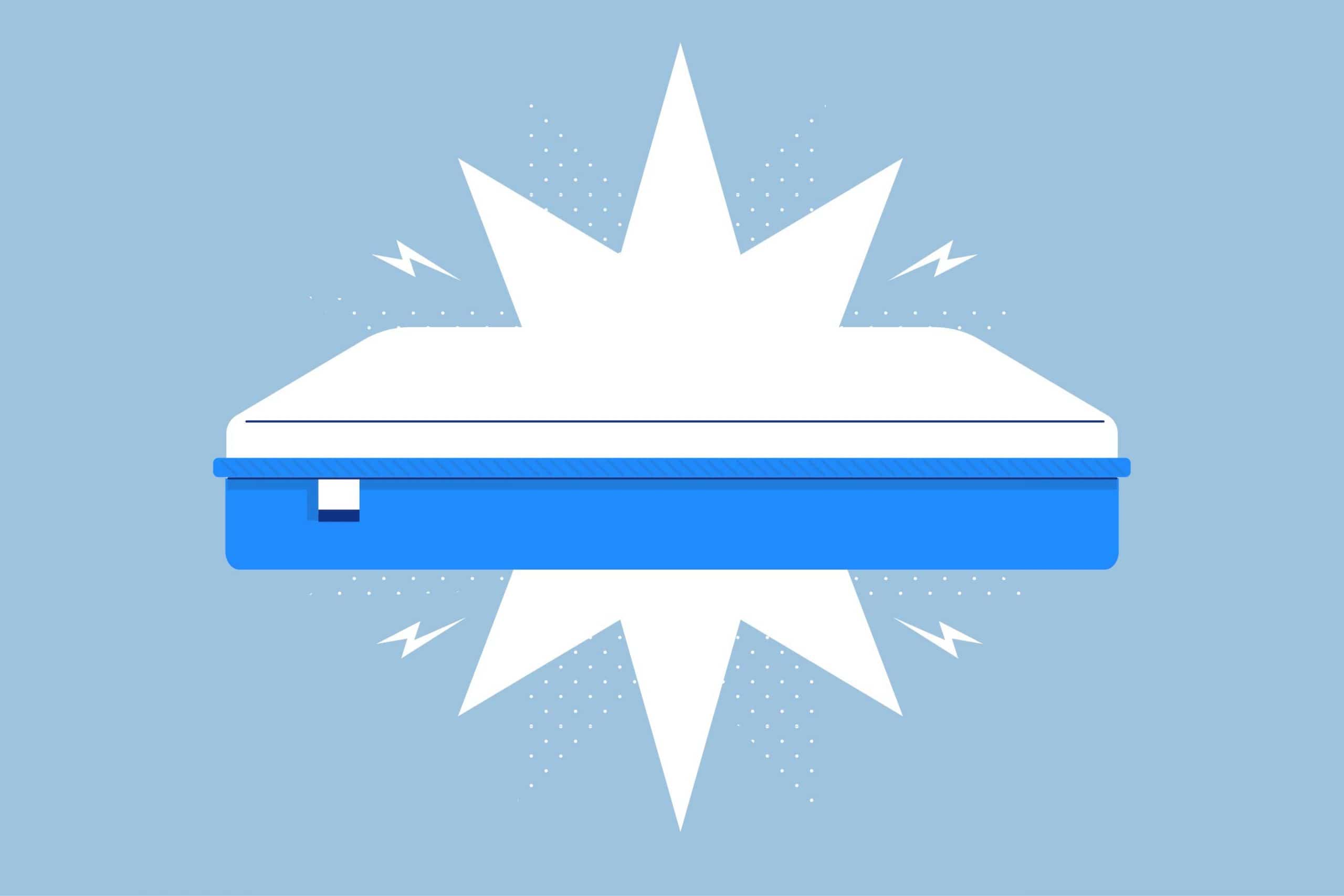Couples struggle the most in trying to find the right mattress because there are more than one person’s sleeping preferences to consider. Some sleepers prefer a softer mattress, while others sleep better on a firmer bed.
Also, consider how a person sleeps— if one person is constantly tossing and turning, the motions plus the noise can cause the other sleeper to wake several times in the middle of the night. Less sleep leads to daytime drowsiness, a problem that affects over 20% of the nation’s population.
As a solution, we at Amerisleep recommend three excellent mattress models, perfect for couples in isolating motion, producing little to no noise, and providing a sleep surface to improve sleep quality for both sleepers.
Consider an Amerisleep Mattress
When on the hunt for the best mattress, couples should consider Amerisleep. Amerisleep designs each of their mattresses with the needs of their customers in mind. Their goal is to provide solutions for better sleep. As couples search for the perfect mattress, they should take into account body weight and sleep position, two major factors any potential mattress buyer should consider. We recommend the AS3, the AS2, or the AS5 as the best mattresses for couples.
Amerisleep AS3
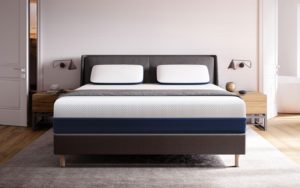 The AS3 is Amerisleep’s medium model and the best overall mattress for couples. The 3-inch layer of Bio-Pur® conforms to the body to relieve pressure points. 2 inches of Affinity with HIVE® technology provides firmer support to the head, back, and legs, while cushioning the shoulders and hips. Bio-Core® supports the body and prevents deep sinkage.
The AS3 is Amerisleep’s medium model and the best overall mattress for couples. The 3-inch layer of Bio-Pur® conforms to the body to relieve pressure points. 2 inches of Affinity with HIVE® technology provides firmer support to the head, back, and legs, while cushioning the shoulders and hips. Bio-Core® supports the body and prevents deep sinkage.
Amerisleep AS2
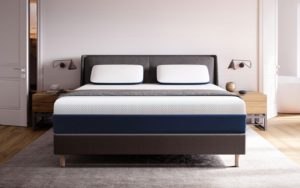 The AS2 is Amerisleep’s medium-firm model. The 2-inch layer of Bio-Pur® cushions the body, relieving pressure points without making couples feel stuck in the mattress. The 3-inch Affinity layer with HIVE® technology evenly supports the body and keeps the spine in neutral alignment. The 7-inch layer of Bio-Core® reinforces the top layers and keeps the body evenly supported without risk of sagging.
The AS2 is Amerisleep’s medium-firm model. The 2-inch layer of Bio-Pur® cushions the body, relieving pressure points without making couples feel stuck in the mattress. The 3-inch Affinity layer with HIVE® technology evenly supports the body and keeps the spine in neutral alignment. The 7-inch layer of Bio-Core® reinforces the top layers and keeps the body evenly supported without risk of sagging.
Amerisleep AS5
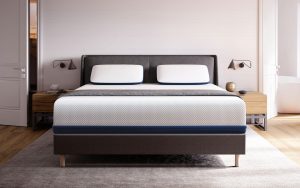 The AS5 is Amerisleep’s softest model. 3 inches of soft and responsive Bio-Pur® relieves pressure points, while the latex-like, 2-inch layer of Active Flex adds extra support, keeping couples on top of the mattress. 2 inches of Affinity with HIVE® technology allows for deep compression for heavier sections of the body, like the shoulders and hips with consistent and durable support from the 7-inch layer of Bio-Core®.
The AS5 is Amerisleep’s softest model. 3 inches of soft and responsive Bio-Pur® relieves pressure points, while the latex-like, 2-inch layer of Active Flex adds extra support, keeping couples on top of the mattress. 2 inches of Affinity with HIVE® technology allows for deep compression for heavier sections of the body, like the shoulders and hips with consistent and durable support from the 7-inch layer of Bio-Core®.
Why Choose Amerisleep?
Amerisleep prides itself on its high-quality materials, eco-friendly production, and its goal to help potential shoppers achieve better sleep. For couples looking for the right mattress, Amerisleep is the solution. They offer five models, each ranging in firmness from the AS1 as their firmest model, to the AS5, their softest model.
Bio-Pur®
By partially replacing petroleum with castor oil in the foam manufacturing process, Amerisleep created Bio-Pur®, a plant-based memory foam that’s more breathable and more responsive than traditional memory foam. Bio-Pur® produces little to no off-gassing odor, and contours to the body to relieve pressure points.
Affinity with HIVE® Technology
The Affinity layer contains a support system known as HIVE® technology. Hundreds of hexagonal-shaped segments form a 5-zoned layer, with firmer support for the head, back, and legs, and softer support for the shoulders and hips. The Affinity layer keeps the spine in alignment, no matter the sleep position.
Bio-Core®
Each mattress contains a base foam called Bio-Core®. Bio-Core® offers consistent support without the risk of premature sagging and deterioration and reinforces the top layers of each mattress. Bio-Core® is a durable foam, built to last for years.
Sleep Trial and Warranty
Amerisleep offers a 100-night sleep trial and a 20-year warranty with the purchase of any of their mattress models. During the 100-night trial period, if the customer doesn’t like the mattress, Amerisleep will work with them to have the mattress donated to a local charity. Please keep in mind that it takes about 30 days for most people to adjust to a new bed.
Most mattresses come with a standard 10-year warranty, but Amerisleep offers a 20-year warranty, one of the best in the mattress industry. The warranty covers manufacturing defects and flaws including cracked foam and sagging greater than .75 inches.
During the first 10 years, Amerisleep will replace or repair the mattress free of charge. During the last 10 years, Amerisleep will choose whether to repair or replace the mattress at a prorated charge to the customer, depending on the year of the claim.
What Should Couples Look For in a Mattress?
Before purchasing a mattress, couples should consider features like motion isolation, cooling, firmness, support, body weight, and sleeping position. Finding a mattress that accommodates these needs will lead to a better night’s sleep.
Motion Isolation
Motion isolation prevents movement from spreading across the mattress surface and disrupting sleep. The type of materials that a mattress contains determines the amount of motion isolation a mattress will have. For example, innerspring and hybrid mattresses both contain support layers of coils, known to create a responsive bounce and less motion isolation. Other types of mattresses, like memory foam and latex, provide more isolation because of the density of the material and lack of coils.
Mattresses with good to excellent motion isolation are great for couples, especially for light sleepers and those who toss and turn at night. Memory foam and latex restrict motion caused by movement, preventing sleep disturbances. Plus, mattresses with good to excellent motion isolation also have less noise potential— memory foam and latex mattresses sleep silently.
Cooling
Some mattress materials retain more heat than others, but manufacturers have taken steps to improve temperature regulation by altering the structure or infusing other materials into the comfort layers, such as gel, charcoal, or copper.
For example, memory foam retains heat; however, manufacturers fix this problem by partially replacing petroleum with plant oil and injecting more air into the material during the manufacturing process. As a result, memory foam becomes breathable and more responsive. Another cooling method is infusing the foam with gel, copper, or graphite to absorb and evenly disperse body heat.
Firmness
Firmness refers to how soft or firm a mattress feels rated on a scale between 1 (the softest) and 10 (the firmest)— most mattresses range between 3 and 8. The right firmness level depends on your favored sleep position and bodyweight. Finding the right firmness may prove difficult for couples because of differing sleep positions and body weight, but a great compromise for both is a medium mattress.
Couples who struggle deciding on the right firmness may find a split mattress option the perfect solution. Split sizes are available in queen, king, and California king.
Support
Support refers to a mattress’s ability to maintain an even surface while in use and keep the spine aligned. An unsupportive surface is uneven, often sagging in more than one area, causing increased pressure and pain. The more weight applied to the sleep surface, the greater the compression, which is why for couples, it’s vital to find a mattress to properly support their combined weight.
Body weight
Body weight is a major factor to consider when buying a mattress, especially when sharing it with someone else. Bodyweight helps determine the type of firmness you should look for in a mattress, and as a couple, you need to consider your combined weight. Most queen and king size beds have a weight limit of 600 pounds or more— exceeding the bed’s weight limit reduces its lifespan by prematurely breaking down materials.
Lightweight Sleepers
Lightweight sleepers weigh 130 pounds or less. They need a mattress with a soft to medium feel to allow their body’s weight to slightly sink into the surface, enabling pressure relief.
Average Weight Sleepers
Average weight sleepers weigh between 130 and 230 pounds. They need a mattress with a medium to medium-firm feel to contour to the body’s natural curves with even support.
Heavyweight Sleepers
Heavyweight sleepers weigh 230 pounds and more. They need a mattress with a medium-firm to firm feel to contour and support their body without sagging. What’s more, heavier folks can be more prone to back pain if they sleep on an unsupportive mattress— the best mattress for back pain is medium-firm to firm with a durable support core.
Mattress Type
Each type of mattress offers benefits and drawbacks, depending on the type of materials each contains. The type of mattress you choose depends on your personal preference. For example, some sleepers may prefer the hug-like sensation of memory foam over the bouncy feel of an innerspring.
Memory Foam
Memory foam is one of the most popular types of mattresses on the market today thanks to the bed in a box online trend.
Memory foam mattresses have optimal pressure-relieving properties because the material contours closely to the natural curves of the body. Memory foam also has excellent motion isolation and sleeps silently— perfect for couples.
One of the drawbacks to memory foam is its heat retention, because of the material encasing the body; however, choosing a mattress with cooling memory foam (plant-based foam, gel memory foam) alleviates this problem. Another drawback to memory foam is its lack of response.
A typical memory foam mattress contains a comfort layer of memory foam and a support layer of high-density foam. The average price for a queen size memory foam mattress is between $500 to $2000.
Innerspring
Innerspring mattresses are the traditional beds many grew up with. They offer great cooling through the open structure of the support layer, a bouncy sleep surface, and great edge support— couples will find it easier to move at night and not worry about rolling off the side of the bed.
Because innerspring mattresses are coil-based they tend to have poor motion transfer isolation with more noise potential from steel coils. An innerspring mattress also lacks pressure relief because of the thin comfort layer.
An innerspring mattress contains a thin comfort layer of foam or fiberfill and a support layer of steel coils. The average price for a queen size innerspring mattress is between $400 to $1500.
Latex
Latex comes in two forms— synthetic and natural. Synthetic latex is made through a chemical process while natural latex comes from the sap of rubber trees which is whipped into a foam.
Dunlop latex is a form of natural latex, more dense and durable than its softer counterpart, Talalay. Talalay latex, while also harvested from the sap of a rubber tree, has polyurethane fillers incorporated during the manufacturing process, so it is not 100% natural like Dunlop.
Latex foam is cooler than memory foam and has a similar feel. Like memory foam, it has excellent pressure relief and motion isolation. However, latex is more responsive than memory foam and a little less contouring.
One drawback to latex mattresses is how heavy they can be— some weigh over 160 pounds. Plus, due to the material, latex mattresses cost more.
Generally, a latex mattress contains a comfort layer of latex foam and a support layer of either high-density foam or latex foam. The average price for a queen size latex mattress is between $900 to $3000.
Hybrid
By combining pressure-relieving memory foam and the responsive bounce of steel coils, mattress manufacturers created the hybrid. Hybrid mattresses have good motion isolation from both the foam comfort layer and the individually-wrapped coils, plus cooling through the open structure of the support layer.
While hybrid mattresses have several benefits, they also come with drawbacks, including heat retention from the memory foam and less pressure relief and noise potential from pocketed coils. Hybrid mattresses are also heavy and difficult to move and come at a higher price tag due to the number of materials they contain.
A hybrid mattress contains a comfort layer at least 2 inches thick of memory foam or latex and a support layer of pocket coils. The average price for a queen size hybrid mattress is between $1200 to $3000.
Mattress Size
For couples, a mattress should be large enough to allow for some personal space— twin, twin XL, and full beds are too small. Instead, choose a queen, king, or California king mattress. The larger mattress size provides more space to move around without feeling crowded, which is especially ideal if one or both sleepers are combination sleepers.
Split mattresses are also a great choice for couples. It can be hard finding a mattress to accommodate two sleep preferences, but a split mattress could be the solution. Split size mattresses contain two twin XL mattresses, each with a different firmness level based on the needs of the sleeper.
Sleeping Position
Sleeping position is another major factor to consider when buying a new mattress. Each sleep position requires a specific level of comfort and support to keep the spine in alignment.
Side Sleeping
Side sleeping is one of the healthiest and most common sleep positions. It allows for better breathing, reduces acid reflux, and removes pressure from off of vital organs, like the heart and liver. Side sleepers should look for a soft to medium mattress— a softer surface cushions the body, relieving pressure points in the shoulders and hips while filling in the large gaps between the body and the surface.
Back Sleeping
Back sleeping naturally aligns the spine because of the back’s direct contact with the surface. Back sleepers face a higher risk of snoring and developing sleep apnea— gravity causes the soft tissue to collapse at the back of the throat, obstructing airways. Back sleepers should look for a medium to firm mattress that provides body contouring and relieves pressure in the back and hips.
Stomach Sleeping
Stomach sleeping is the least common and unhealthiest sleep position due to the amount of pressure it puts on the spine, leading to neck strain and lower back pain. Neck strain is caused by the sleeper twisting their head at an unnatural angle to breathe. Back pain is caused by gravity pulling the midsection downward, forcing the natural curve of the spine to straighten.
If you’re committed to sleeping on your stomach, look for a medium-firm to firm mattress to keep the body on top of the sleep surface with some pressure relief. Stomach sleepers can receive further support by adding a thin pillow under the hips.
Combination Sleeping
Combination sleepers, also known as restless sleepers, switch between two to three sleep positions per night. Benefits to combination sleeping include better breathing, natural alignment, minimized acid reflux, and less pressure on the vital organs. Drawbacks include risk of snoring, potential to develop sleep apnea, lower back pain, and neck strain.
Combination sleepers need a medium to medium-firm mattress to provide consistent comfort and support, and to keep the spine in alignment, no matter the sleep position.
The Right Mattress for Couples
For couples, finding a mattress to satisfy both parties can be a challenge. Luckily, Amerisleep offers three great models, the AS3, the AS2, and the AS5. The AS2 has a firmer feel and the AS5 is softer, and the AS3 is the perfect medium between the two. All three models feature responsive, breathable foam layers, built to provide the perfect balance of comfort and support.
About the author
McKenzie Hyde is a Certified Sleep Science Coach and a full-time writer focused on sleep health and the mattress industry. She currently writes articles on a variety of topics, ranging from sleep hygiene to the newest trends in the mattress and bedding industry. Just some of the topics she has covered include best sleep practices for students, the consequences of going without sleep, and choosing the right bed if you suffer from back pain. McKenzie Hyde holds a Master of Arts degree from Utah State University where she studied literature and writing. While there, she taught argumentative writing and wrote a variety of articles and analyses for literary and academic journals.
View all posts